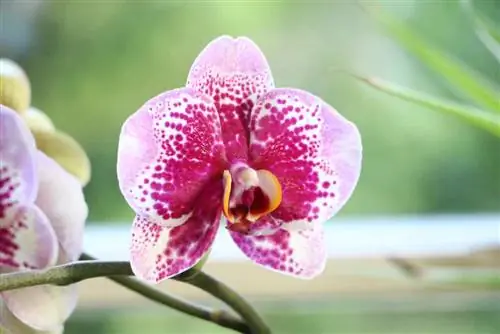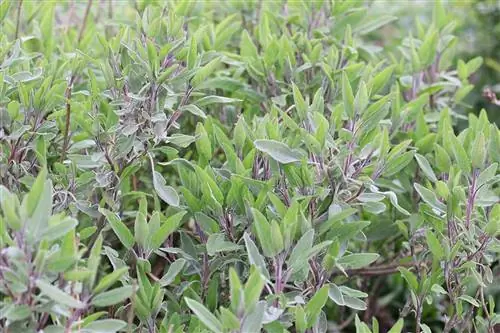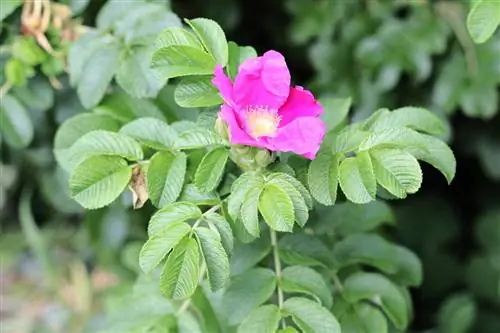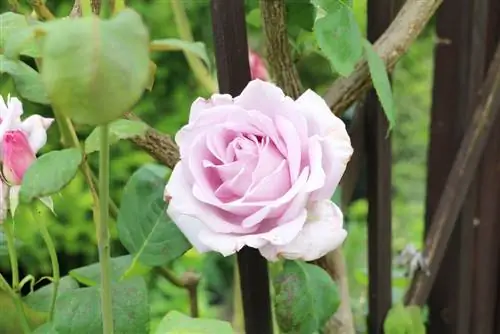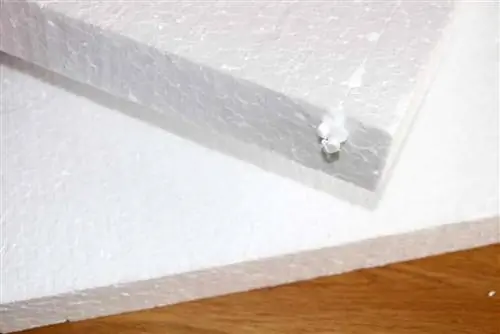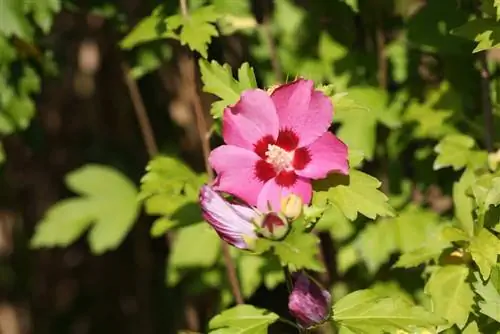- Author admin [email protected].
- Public 2023-12-17 03:39.
- Last modified 2025-01-24 12:45.
The Phalaenopsis is one of the best-selling and easiest-care orchids ever. Its flowers are reminiscent of colorful moths or butterflies, which gave it the name butterfly orchid or butterfly orchid. In many cultivated forms, the flowers are not only particularly colorful and large, they also last for weeks. The Phalaenopsis can be easily recognized by its growth habit. It grows from just one stem with thick, fleshy leaves. There are no warnings. Caring for the exotic flower is different from caring for other houseplants in many ways.
Short profile:
- Botanical name: Phalaenopsis
- other names: butterfly orchid, butterfly orchid, Malay flower
- belongs to the orchid family
- Leaves: elongated to round-oval, round end, very fleshy, olive green
- originate from a shoot axis and grow upwards without branching
- Flowers: appear on a flower stalk, always several flowers in the shape of a butterfly
- forms aerial roots
Species and occurrence
There are about 60 different species in the genus Phalaenopsis, found in tropical Asia and the rainforests of northern Australia. Most species grow as epiphytes on trees. In their homeland it is uniformly warm and very humid, so that the butterfly orchids can absorb sufficient amounts of nutrients and water through their aerial roots. We have an enormous variety of these orchids available in stores as crosses and hybrids.
Care
Learn everything about caring for the butterfly orchid below
Location
As with most plants, temperature, humidity and light are crucial location factors for the orchid. The Phalaenopsis needs a bright location without direct sun. If you want to grow the orchid on a south-facing window (or southwest window), you should protect it with shady neighboring plants, a curtain or blinds. The leaves of a butterfly orchid are olive green in optimal condition. If they are significantly darker in color, this means that the plant is not getting enough light. Reddish foliage indicates locations that are too sunny. Once the plant has flowers, it can be placed anywhere in the house as long as it is protected from direct sunlight.
- Light requirements: bright or partially shaded
- no direct midday sun
- East windows or bathroom windows with privacy protection are ideal
- Temperature: 18 to 25 degrees all year round
- high humidity
- protected from cold drafts
Pouring
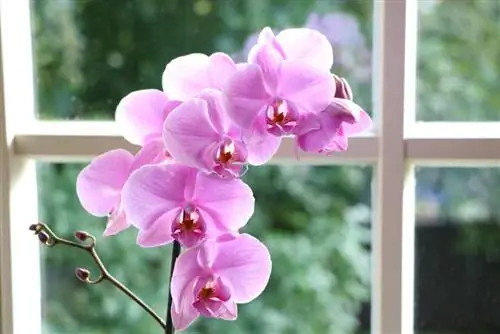
Caring for Phalaenopsis includes regular watering. The orchid is always watered when the substrate on the surface is dry. How often the tropical epiphyte needs water depends on the size of the orchid and also on the substrate. Light and temperature also have an influence on irrigation. If the butterfly orchid is in a bark substrate, it needs to be watered more frequently than in a moss substrate, as the moss can store moisture better. It's easy to tell when the orchid needs to be watered again. To do this, simply take the plant out of the planter. If the bale feels very light, it is time to water. The tropical plant is best immersed in water at room temperature. It is important to let the excess water drain well after diving so that it does not become waterlogged. Too much water in the ball promotes rotting of the sensitive aerial roots. In summer, diving takes place about once a week; in winter, it is usually sufficient to water every two weeks. However, the root ball should be checked weekly for moisture. Orchids that are tied to a stone, a trunk or a root with some moss are sprayed daily in the root area, but can also be carefully dipped.
Tip:
Please do not use distilled or desalinated water for watering, this is not good for the plant.
Fertilize
Fertilizers are administered to Phalaenopsis via the irrigation water. In summer it makes sense to add some special orchid fertilizer to the water every other dip. It has proven useful to only use half the concentration of the prescribed amount of fertilizer. In order to remove dried fertilizer residues from the substrate, the root ball should be rinsed with clear water once a month. Since the orchid does not take a break in winter, it is continued to be fertilized in the cold season, but only once a month.
Supporting flowers
At least once a year, a thick flower shoot grows out of the leaf axils, which initially grows in length without branching or flowering. So that the flowers come into their own later and the flower stem does not break off when there are numerous flowers, it is advisable to attach the shoot to a support piece of wood straight away. There are special clamps for this, but you can also use a thick thread or a thick plastic-coated wire. It is important that the stem still has enough room to spread. If the holder is too tight, it cuts off the water and nutrient supply and the flower wilts prematurely.
Cutting
Since pathogens can enter the plant through cuts on the leaves, the leaves of the Phalaenopsis should not be cut. If the lower pairs of leaves wilt, you can simply wait until they are completely dry. Then they can be easily plucked out by hand. After flowering, the flower stem can be cut back. It is possible to cut off the entire stem down to the base of the leaves. However, if around two nodes (eyes) remain, the orchid will often bloom again from this point of vegetation after around four to six weeks. If the plant is still very young and only has three to five very small, short leaves, it is advisable to cut back the flower stalk completely. The reason for this is that flowering requires a lot of energy from the butterfly orchid. If you cut back the dead stems completely, the orchid will put all of its energy into growth and will gain a lot of leaf mass by next year. The flower stems should always be cut with a clean (sterile) knife or a new razor blade to prevent bacteria, fungi or viruses from entering the wound. If only the tip is cut, you may not cut directly above the point of vegetation, but about three centimeters above it.
- does not require cutting
- grows very slowly
- Do not cut the leaves (pathogens can enter through the wounds)
- only cut withered flower stems
- for young plants: cut off to the base
- for older plants: only cut up to 3 cm above the second eye
- often blooms again
- Young plants are weakened too much by this renewed flowering
Substrate
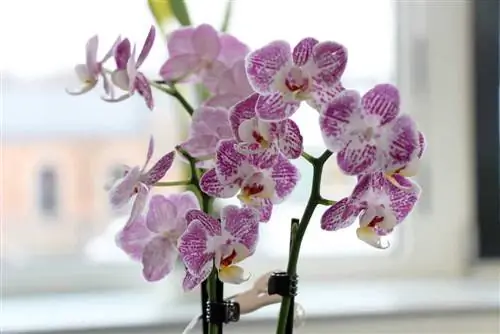
The orchid actually grows on trees in tropical rainforests, where there is high rainfall and high humidity. For this reason, it forms so-called aerial roots through which the plant absorbs moisture. These roots are very thick and branch little. Under no circumstances should they be planted in normal potting soil, as the roots will begin to rot very quickly under these conditions. A very coarse substrate that retains moisture well is ideal. The water gradually evaporates and increases the humidity locally around the roots.
- Pieces of wood or tree bark
- the bigger the plant, the coarser the substrate
- Mosses (store water very well)
Tip:
The orchid can also be tied to a tree trunk or a decorative wooden root with some moss on the aerial roots.
Repotting
Every one to three years, when the aerial roots have already completely grown through the substrate or incrustations are visible, the Phalaenopsis needs fresh substrate and possibly a larger planter. To repot, the plant is pulled out of its old pot and the substrate is shaken out of the roots. Newly formed aerial roots are carefully bent downwards without breaking them off. There are special plant pots for orchids that are made of transparent plastic to make it easier to view the roots. In addition, the bottom has a curvature on the inside that prevents the roots of the butterfly orchid from standing in water. If you use normal plant pots, you should therefore create a drainage layer. This can be filled either directly into the planter or into the planter.
- only repot well-rooted plants
- If you water with normal tap water, you should replace the substrate every year
- shake out old substrate
- place in new, clean container
- bend the aerial roots slightly downwards
- fill in fresh substrate on the side
- tap firmly on the surface several times so that the substrate settles
- the bigger the plant, the coarser the substrate
Wintering
The optimal place for cultivating the butterfly orchid in winter is the south window, where the plant gets the most light. Every ray of sunshine counts in the dark winter months. If the tropical plants are too dark, it can happen that individual buds of the otherwise robust Phalaenopsis dry out, even though the orchid is provided with sufficient amounts of irrigation water. The orchid should also be sprayed occasionally with lukewarm water to increase the humidity. In the cold season, the plant does not go into a resting phase, after all, even in its homeland it is consistently warm all year round. It therefore requires moderate temperatures even in winter, which must never fall below 16 degrees. This also applies to the cool air, which can cause damage to plants when ventilated.
Tip:
Watere a little more slowly in winter and only fertilize monthly.
Humidity
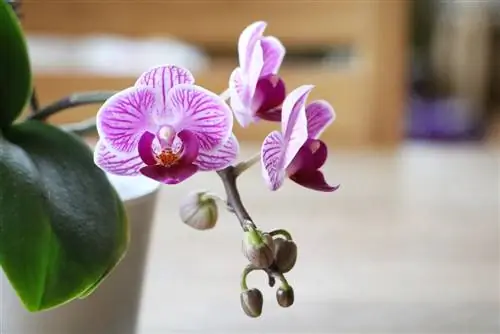
Orchids like Phalaenopsis love moist air. The humidity can never be high enough. But they also tolerate less humid conditions. It is only in the winter months that many butterfly orchids find it difficult to create heated and therefore dry rooms. However, simple means can be used to ensure that the humidity at the location increases:
- Fill the bottom of a planter with expanded clay
- Size: at least 4 cm larger diameter than the orchid pot
- Just cover the expanded clay with water
- the roots must not come into contact with this water (waterlogging)
- Spraying the leaves regularly also provides relief
- use low-lime, room temperature water
Propagate
Sometimes small leaves and roots form on a flower. These are so-called Kindel. These are the offshoots of the Phalaenopsis through which the plant reproduces. Not all plants form these children; this often only happens at an advanced age. At first, these offshoots are not yet able to survive without the mother plant, so they have to remain in place for a few months. During this time, the children grow and get their water and nutrients through the connection to the mother plant.
- Disconnect when the child has at least three leaves and three to four aerial roots
- cut with a clean, sharp knife or razor blade
- disconnect close to the child
- plant in fine substrate
- alternatively tie it to a base with moss
- spray daily with room temperature water
The plants are placed brightly but without direct sun. After a few weeks, the young Phalaenopsis begins to grow. From now on, the orchid will be cared for like a full-grown plant.
Diseases and pests
If the external appearance or flowering power of the butterfly orchid decreases, this can be due to both care errors and pests.
- Scale insects: most common pest on the butterfly orchid, usually recognized by honeydew, isolate the plant, use pesticides or home remedies (such as soap solution)
- Bacteria,FungiandViruses: prefer to penetrate through injuries, but can also occur when there is insufficient ventilation, they often leave brown, yellow or black dots on the leaves, cut off affected parts of the plant generously (sterile knife)
- Care errors: the most common mistake is too frequent watering and waterlogging, rotten roots and a sick plant are the result
- Location problems: too much or too little light is reflected in the color of the leaves (colored too light or too dark)
- Sunburn: whitish spots with dark edges
- Bud fall: indicates a lack of light, usually in winter, in brighter places
Conclusion
The Phalaenopsis, also known as the butterfly orchid because of its flowers, is one of the easy-care and undemanding orchids. It forgives even minor care mistakes and does not require particularly intensive care. Just a weekly dip of the root ball, occasional fertilization and a warm and bright location without direct sun are enough to encourage the beautiful plant to bloom regularly.

